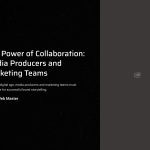 In today’s digital age, the collaboration between media producers and marketing teams is essential for successful brand storytelling. Media producers create visually compelling content, while marketing professionals ensure it reaches the right audience through strategic distribution. This partnership enhances brand visibility, engagement, and ultimately, business growth.
In today’s digital age, the collaboration between media producers and marketing teams is essential for successful brand storytelling. Media producers create visually compelling content, while marketing professionals ensure it reaches the right audience through strategic distribution. This partnership enhances brand visibility, engagement, and ultimately, business growth.

The Role of Media Producers in Marketing Campaigns
Media producers focus on crafting high-quality content such as videos, graphics, animations, and podcasts. Their expertise in storytelling, cinematography, and editing brings marketing messages to life. Without them, campaigns would lack the engaging visuals that capture audience attention.
Marketing teams rely on media producers to align content with their brand’s voice and campaign objectives. They provide insights on target demographics, platform preferences, and key performance indicators (KPIs) to ensure the content performs well. This synergy enables brands to maintain a cohesive image across all marketing channels.


How Marketing Teams Guide Content Strategy
Marketing professionals conduct market research, analyze consumer behavior, and develop data-driven strategies. Their insights help media producers create content that resonates with audiences. By understanding trends, audience preferences, and competitor strategies, marketing teams ensure that media production aligns with overall business goals.
For instance, if analytics show that short-form videos drive the most engagement on social media, the marketing team may request media producers to focus on creating TikTok and Instagram Reels content. This type of informed decision-making ensures efficiency and maximizes content impact.

Case Study: A Successful Media-Marketing Collaboration
A great example of media and marketing collaboration is a global fashion brand launching a new collection. The media production team creates a high-quality promotional video featuring models, behind-the-scenes footage, and product close-ups. Meanwhile, the marketing team plans the campaign rollout, deciding on social media platforms, influencer partnerships, and paid advertising strategies.
The result? A visually stunning campaign that not only showcases the new collection but also reaches millions of potential customers through targeted ads, organic social media shares, and PR outreach.

The Impact of Social Media on Media Production
Social media platforms have revolutionized the way media producers and marketers collaborate. The rise of video-centric platforms like YouTube, Instagram, and TikTok has increased demand for engaging content. Media producers must adapt their production techniques to fit short-form and mobile-friendly formats.
Marketers, on the other hand, optimize video descriptions, hashtags, and engagement strategies to increase visibility. Together, they test different content formats, analyze performance metrics, and refine their approach based on audience response.
Overcoming Challenges in Media-Marketing Collaboration
Despite their synergy, media producers and marketing teams sometimes face challenges. Common issues include misalignment of creative vision, tight deadlines, and budget constraints. Effective communication and workflow management are key to overcoming these challenges.
Project management tools like Asana, Trello, or Slack help streamline collaboration by setting clear timelines and responsibilities. Regular meetings, creative briefs, and feedback loops ensure that both teams are on the same page, reducing friction and maximizing efficiency.


uture Trends in Media and Marketing Collaboration
As technology evolves, the collaboration between media producers and marketing teams will continue to innovate. Emerging trends include:
- AI-powered content creation: AI tools help automate video editing, generate captions, and personalize content.
- Interactive and immersive experiences: Augmented reality (AR) and virtual reality (VR) will play a bigger role in marketing campaigns.
- Data-driven content personalization: Advanced analytics will allow hyper-targeted content strategies based on user behavior.
By staying ahead of these trends, media producers and marketers can create more impactful campaigns that resonate with audiences worldwide.
*Capturing unauthorized images is prohibited*

